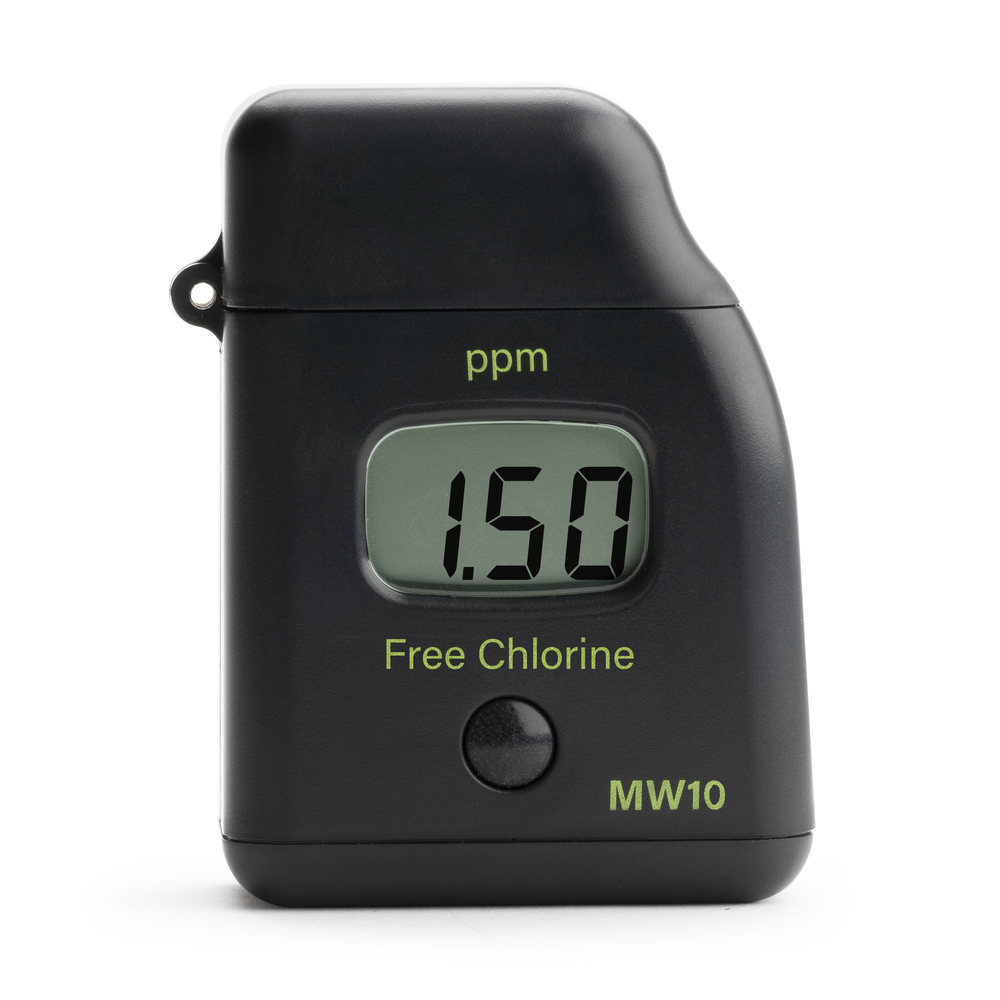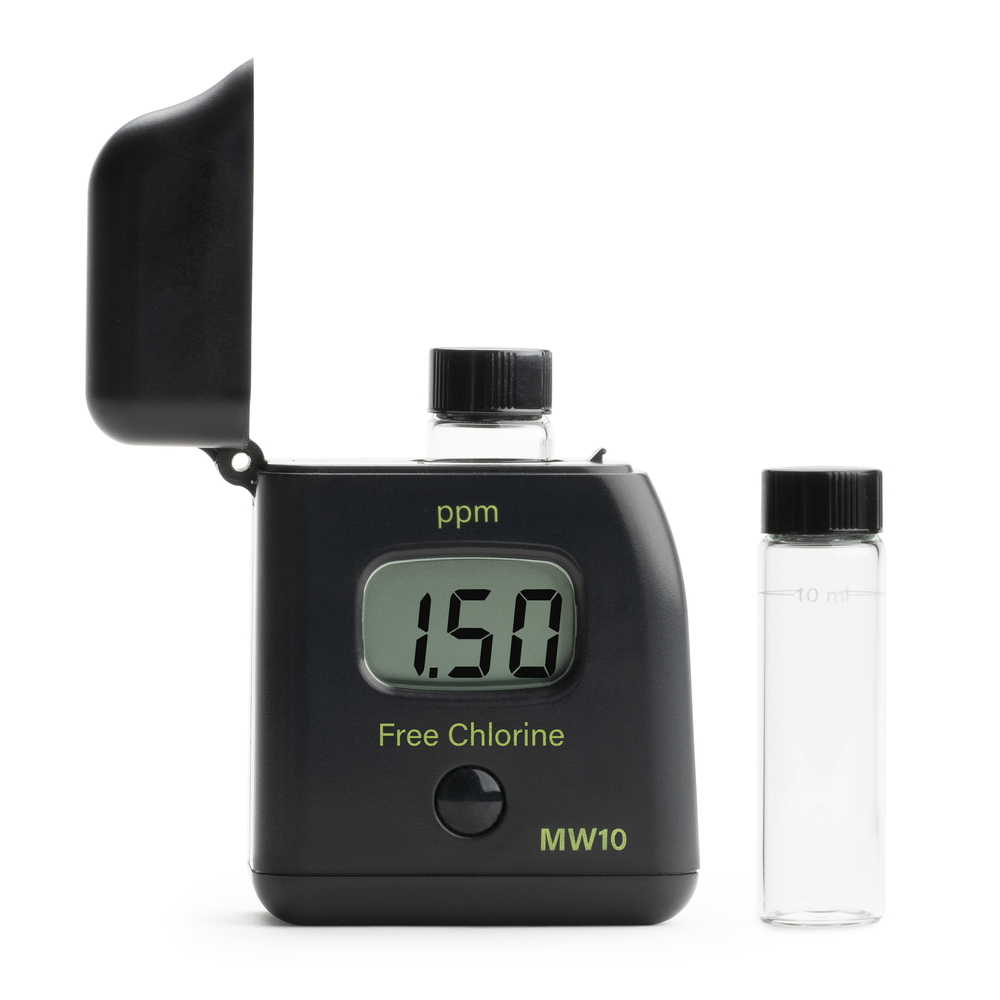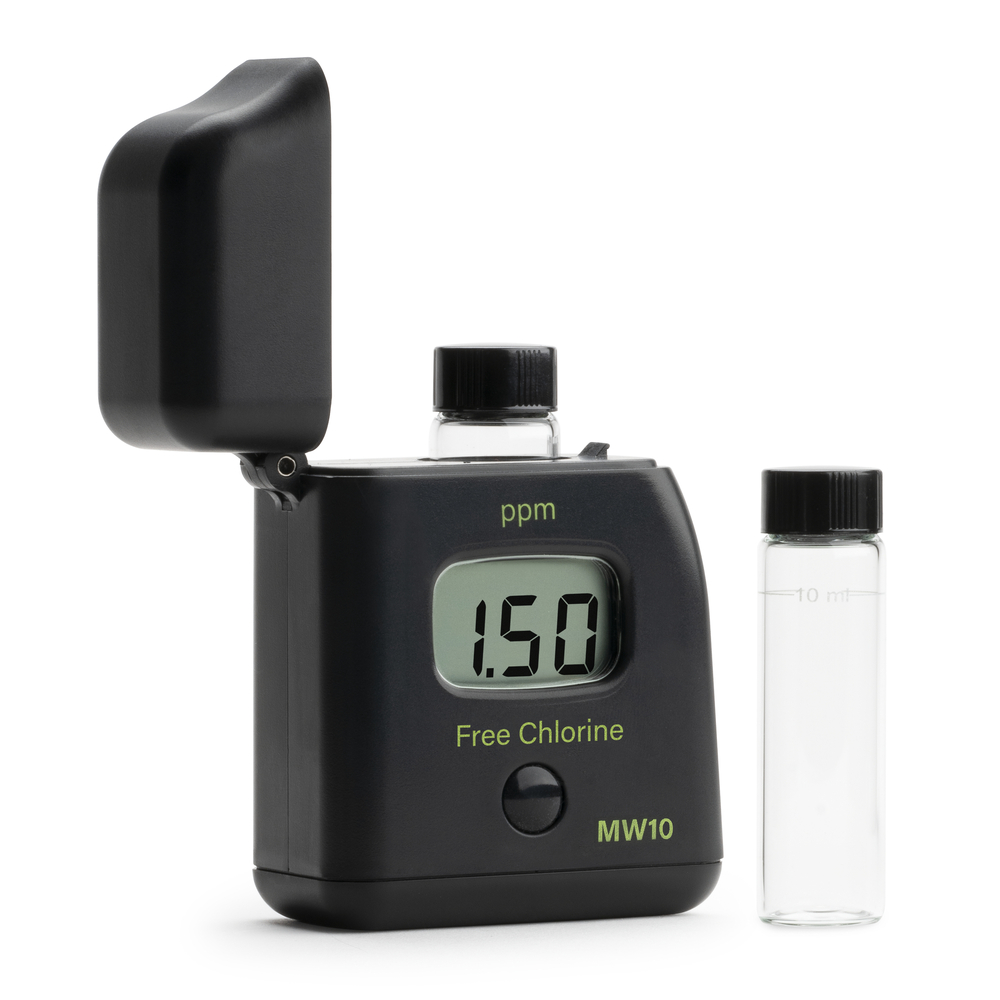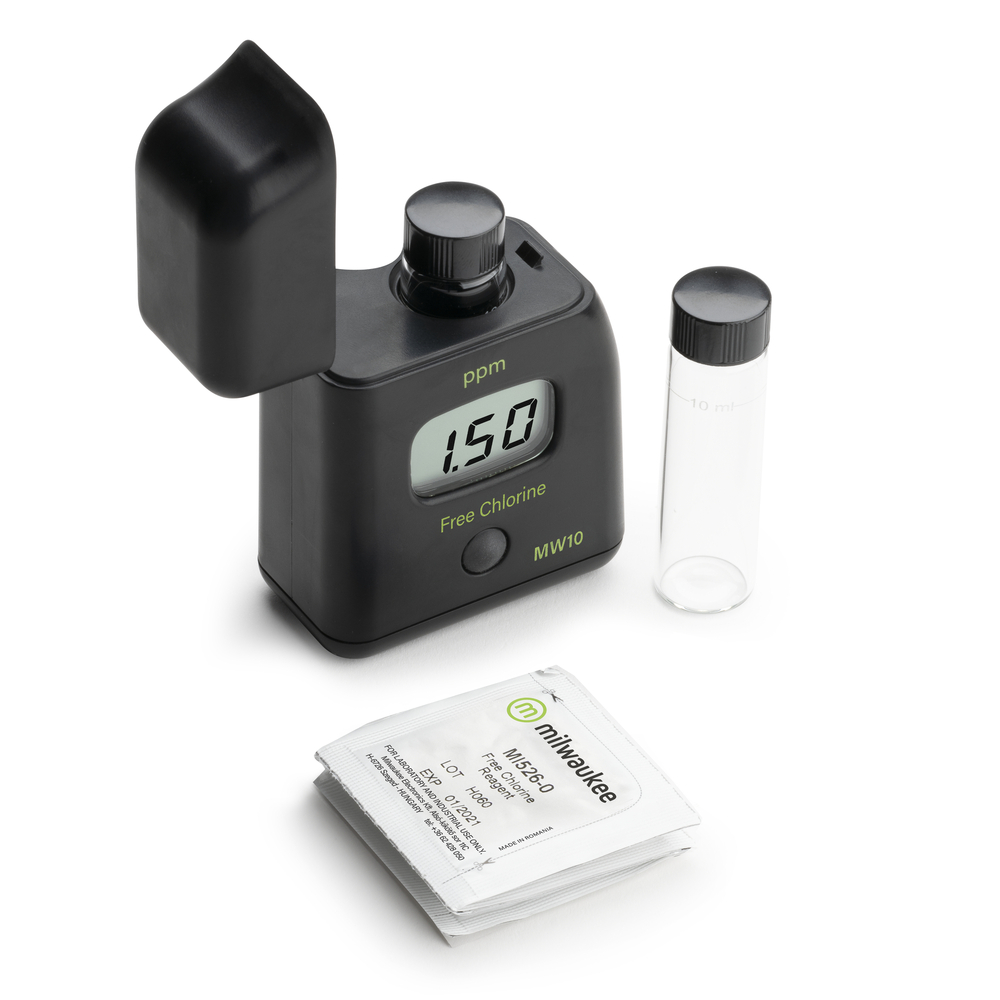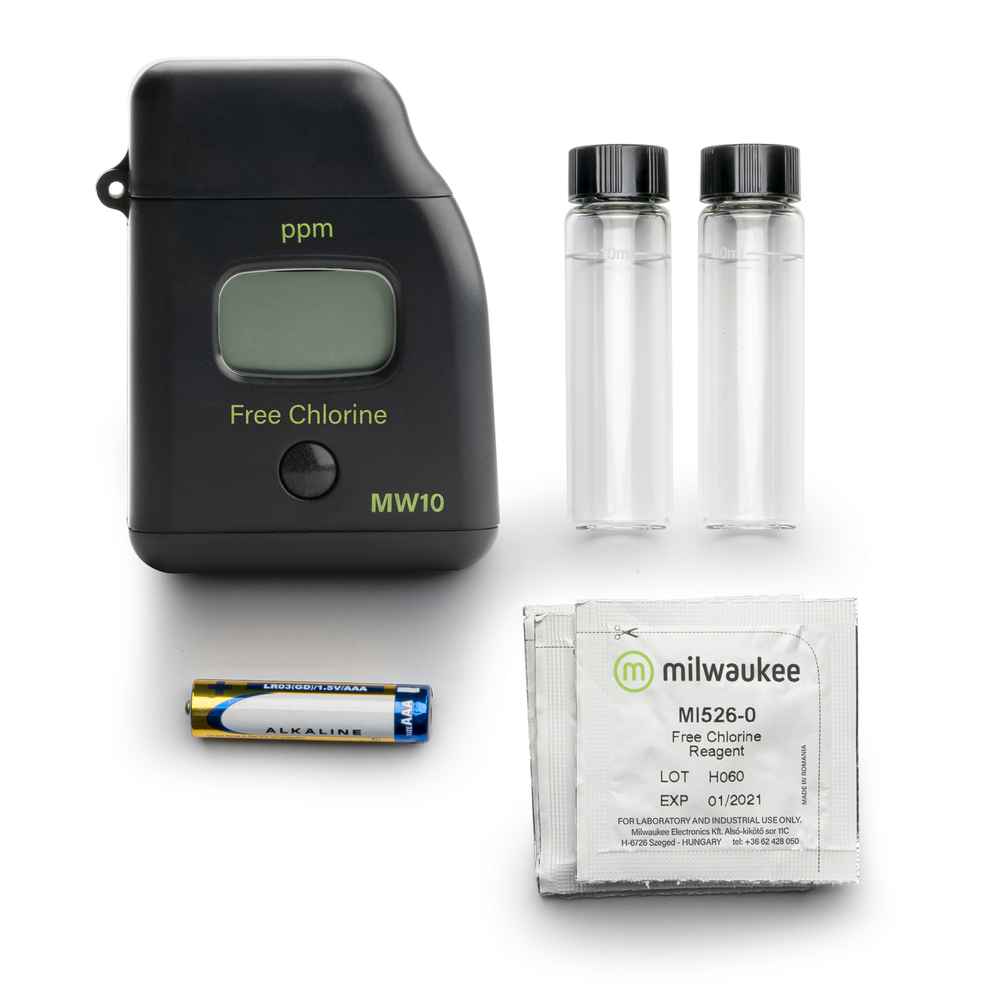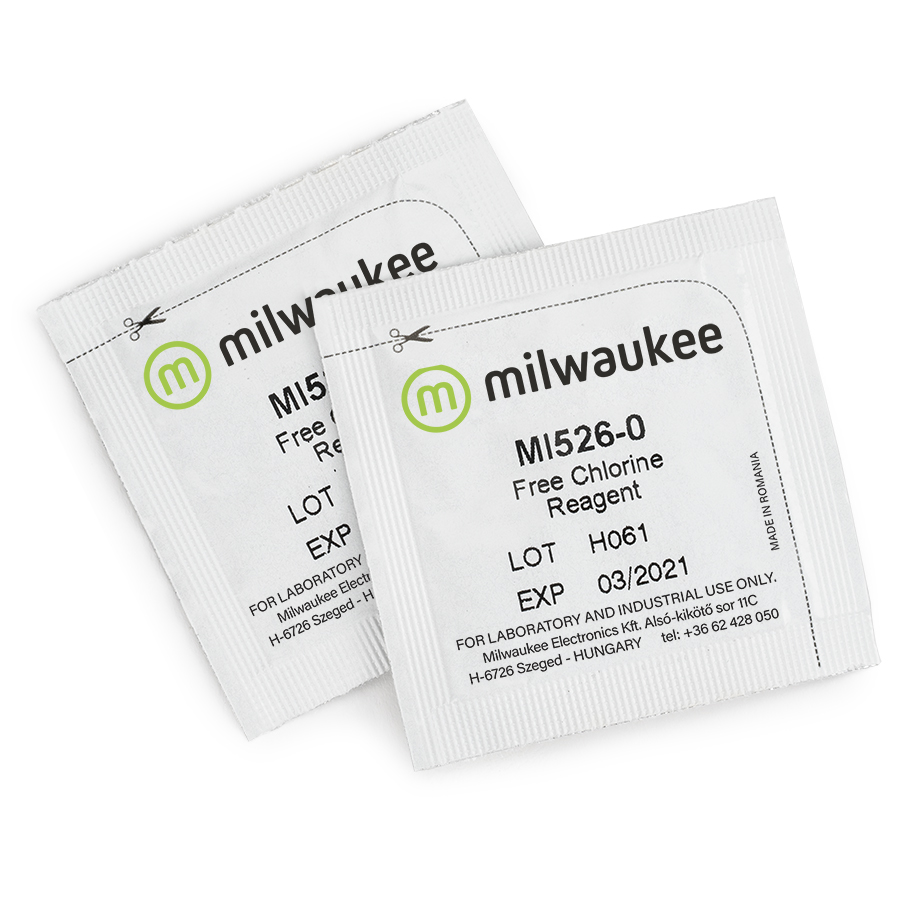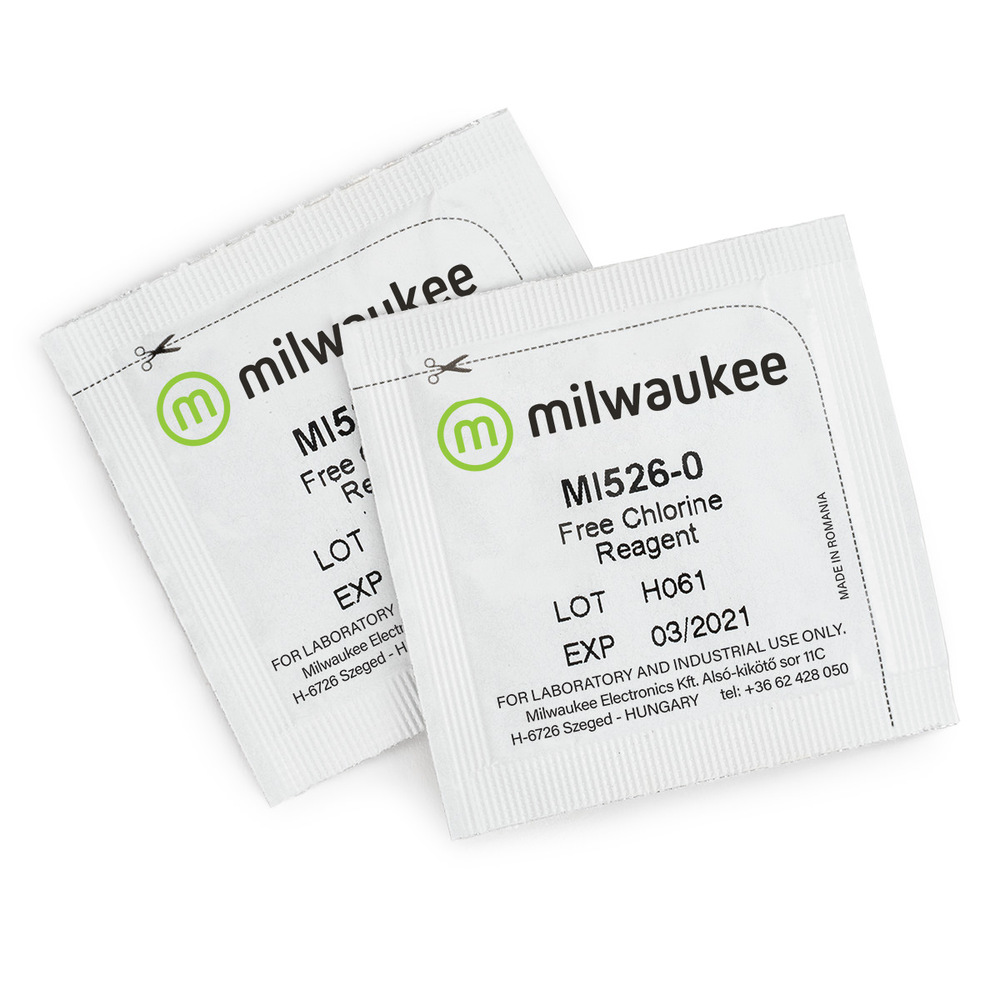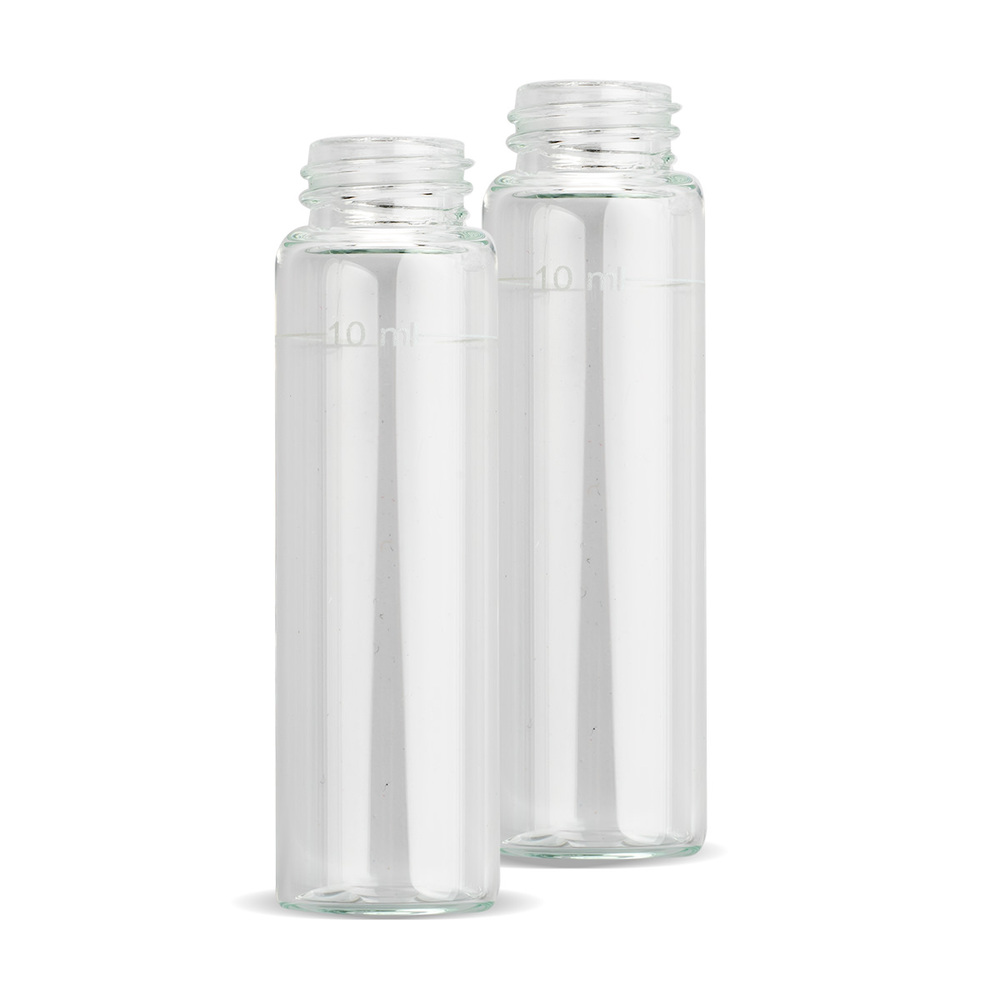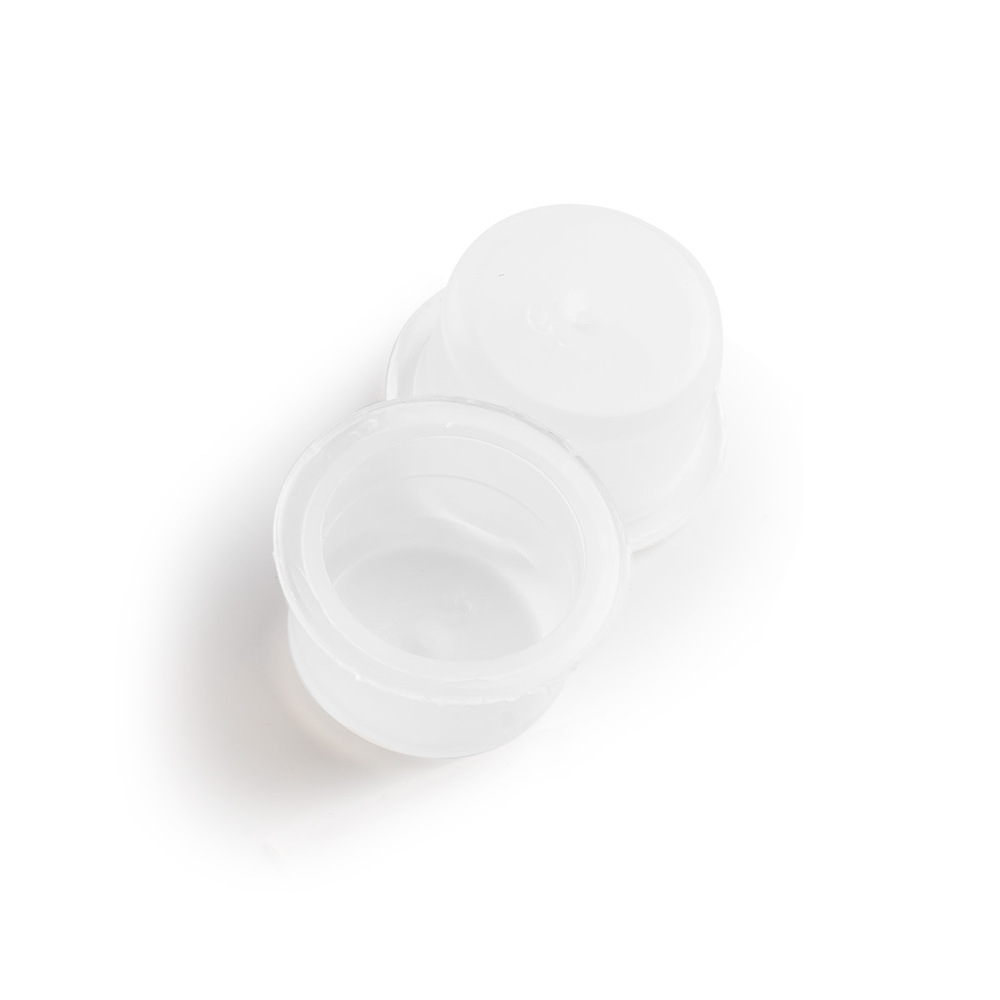Your shopping cart is currently empty.
Milwaukee MW10 Digital Free Chlorine Tester – Precision Chlorine Testing Made Simple
In the world of water quality, precision and speed are non-negotiable. Whether you're managing a public water supply, maintaining a crystal-clear swimming pool, or safeguarding aquatic life in an aquarium, knowing exactly how much free chlorine is present in your water is critical. Chlorine is one of the most widely used disinfectants, but inaccurate levels – too high or too low – can lead to major health risks or system inefficiencies.
That’s where the Milwaukee MW10 Digital Free Chlorine Tester comes in. Designed with simplicity, reliability, and field-ready durability in mind, the MW10 empowers professionals and enthusiasts alike to measure free chlorine levels quickly and accurately – anytime, anywhere. No more subjective color matching. No more ambiguity. Just digital accuracy in the palm of your hand.
Compact, portable, and engineered to meet USEPA Method 330.5 standards, the MW10 is ideal for fast, on-the-go water quality testing. Its intuitive design, combined with powerful performance, makes it a go-to solution for water treatment specialists, pool operators, educators, and more.
Why Choose the Milwaukee MW10?
- High Accuracy & EPA Compliance: Delivers reliable results from 0.00 to 2.50 mg/L (ppm) with ±0.03 mg/L ±3% of reading accuracy. Follows USEPA Method 330.5 for compliance and trust.
- Compact & Portable: Pocket-sized design for effortless field testing – ideal for on-site water assessments.
- Fast & Easy Testing: Simple two-reagent system with easy-to-follow steps delivers results in under a minute.
- Digital Readout: Eliminates interpretation errors associated with traditional color comparator kits.
- Low Maintenance: Durable housing and user-friendly interface designed for long-term, low-hassle use.
- Long Battery Life: Powered by a standard 1.5V AAA battery for up to 500 tests, with automatic shut-off for power conservation.
Applications
The Milwaukee MW10 Free Chlorine Tester is a versatile, portable photometer designed for measuring free chlorine levels in water. Its applications span various industries and settings where accurate chlorine monitoring is essential. Below is a list of its primary applications, starting with the most critical and widely used.
1. Drinking Water Treatment & Distribution
Ensuring safe drinking water requires precise monitoring of free chlorine levels to maintain effective disinfection without exceeding regulatory limits. The MW10 is ideal for municipal water systems, private wells, and on-site testing by water utility personnel.
2. Wastewater Treatment
In wastewater management, controlling chlorine levels is crucial to prevent environmental harm and comply with discharge regulations. The MW10 facilitates quick assessments of chlorine concentrations in treated effluents.
3. Swimming Pools & Spas
Maintaining appropriate chlorine levels in recreational water bodies is vital for user safety and comfort. The MW10 offers pool operators and homeowners an accurate tool for routine monitoring, ensuring water remains within safe and pleasant parameters.
4. Aquariums & Aquaculture
Fish and aquatic organisms are sensitive to chlorine. The MW10 assists aquarium enthusiasts and aquaculture professionals in detecting and managing chlorine levels, safeguarding aquatic life.
5. Food & Beverage Processing
Chlorine is commonly used for sanitizing equipment and surfaces in food and beverage industries. The MW10 helps ensure that residual chlorine levels are within acceptable limits, preventing contamination and ensuring product safety.
6. Laboratories & Research
In scientific research and laboratory settings, precise measurement of chlorine is often required. The MW10 provides researchers with reliable data for experiments and analyses involving water quality.
7. Educational Settings
Educators can utilize the MW10 to teach students about water quality testing and the importance of chlorine monitoring, providing hands-on experience in environmental science and chemistry courses.
8. Agriculture & Irrigation
In agricultural practices, water quality impacts crop health. The MW10 aids farmers and agronomists in monitoring chlorine levels in irrigation water, ensuring it is safe for crops and soil.
The Milwaukee MW10's compact design, ease of use, and accurate digital readings make it a valuable tool across these diverse applications. Its adherence to the USEPA Method 330.5 ensures reliable and standardized measurements of free chlorine in various water samples.
Proper Care & Maintenance
To ensure the longevity and accuracy of your MW10 colorimeter, follow these maintenance best practices:
Cleaning
After each use, rinse the cuvette thoroughly with distilled or deionized water. Avoid scratches or residue that could interfere with optical readings. For stubborn residues, use a soft cloth and mild detergent.
Storage
Store the MW10 in a dry, dust-free environment. Always keep the optical path clean and covered when not in use. Remove the battery if the unit won’t be used for extended periods.
Reagent Handling
Use only Milwaukee reagents (MI524-25) for consistent and accurate results. Store reagents in a cool, dark place and avoid exposure to heat or moisture. Always check expiration dates before use.
Calibration & Verification
Periodically test your MW10 against known standard solutions to verify performance. If results start to drift, check reagent quality and cleanliness of the cuvette before contacting support.
Upgrade your chlorine testing routine with the Milwaukee MW10 – fast, accurate, and built for real-world use.
Specifications
Application
The Milwaukee MW10 Free Chlorine Mini Colorimeter is a versatile, portable photometer designed for measuring free chlorine levels in water. Its applications span various industries and settings where accurate chlorine monitoring is essential. Below is a list of its primary applications, starting with the most critical and widely used.
Drinking Water Treatment & Distribution
Ensuring access to safe, potable water is one of the most essential functions of any public health infrastructure. At the heart of this mission is free chlorine monitoring, a crucial process for disinfecting water and eliminating pathogens like bacteria, viruses, and protozoa.
However, this is a delicate balance:
- Too little chlorine, and harmful microorganisms can survive, putting public health at risk.
- Too much chlorine, and you risk unpleasant taste and odor, corrosion of pipes, and the formation of potentially harmful by-products like trihalomethanes (THMs).
The Milwaukee MW10 provides a simple, portable, and highly accurate way to measure free chlorine levels in drinking water – helping water technicians, field inspectors, and maintenance crews make data-driven adjustments on the spot.
This makes the MW10 ideal for:
- Municipal water treatment plants conducting routine chlorination monitoring at distribution points
- On-site testing at reservoirs, pipelines, or storage tanks
- Well owners verifying the safety of their private water supply after disinfection treatments
- Emergency water quality assessments after contamination events or during system maintenance
Its ease of use means even small water utilities and rural communities with limited technical resources can achieve professional-grade monitoring – right from the field.
How to Use the MW10 for Drinking Water Testing
- Collect Your Sample
- Rinse the included cuvette 2–3 times with the water sample you are about to test.
- Fill the cuvette to the marked line (approximately 10 mL) with your drinking water sample.
- Zero the Instrument
- Wipe the outside of the cuvette with a clean, lint-free cloth to remove any droplets or fingerprints.
- Insert the sample cuvette into the MW10 without any reagents and press the button. This sets a “zero” reference point.
- Add Reagent
- Remove the cuvette and carefully add one packet of the MI524-25 free chlorine reagent.
- Cap the cuvette and gently invert it several times to fully dissolve the reagent.
- Insert and Read
- Reinsert the cuvette into the MW10.
- Press the button again. The MW10 will display the free chlorine level (in ppm) on its digital screen within seconds.
- Interpret the Results
- According to the WHO and EPA, free chlorine levels should generally be between 0.2 and 0.5 ppm for safe and effective disinfection.
- Levels over 1.0 ppm may be excessive for drinking water and could affect taste or safety.
- Make any dosing or treatment adjustments based on the result.
- After Testing
- Rinse the cuvette thoroughly with distilled or deionized water.
- Store your MW10 in a dry place away from sunlight.
Wastewater Treatment
In wastewater treatment, chlorine is commonly used in the final disinfection stage to eliminate pathogenic microorganisms before the treated water is discharged into the environment. However, while disinfection is vital for public health, residual chlorine levels must be carefully controlled – especially when water is released into natural bodies of water such as rivers, lakes, or coastal zones.
Why It Matters:
- Excess chlorine in discharged effluent can harm aquatic ecosystems, killing beneficial microorganisms, fish, and plants.
- Insufficient chlorine can leave dangerous bacteria or viruses in the effluent, potentially contaminating downstream water sources.
- Environmental agencies typically impose strict limits (e.g., <0.5 ppm) for free chlorine levels in treated wastewater, making real-time monitoring an operational necessity.
The Milwaukee MW10 empowers wastewater operators, technicians, and environmental consultants to quickly and accurately measure free chlorine on-site, without needing a laboratory. Its compact size and digital readout reduce human error and allow for spot-checks at various discharge points, holding tanks, and treatment stages.
Whether used at a municipal treatment plant, an industrial facility, or a decentralized wastewater system, the MW10 ensures regulatory compliance and environmental protection.
How to Use the MW10 for Wastewater Testing
- Sample Preparation
- Wastewater samples often contain particulates and organic matter. It is recommended to filter the sample (e.g., using a 0.45 μm filter) if clarity is poor, as turbidity can interfere with optical readings.
- Rinse the cuvette several times with the filtered wastewater sample.
- Fill the Cuvette
- Fill the cuvette with the filtered sample up to the 10 mL mark.
- Wipe the outside with a clean, dry cloth to remove water and fingerprints.
- Zero the Meter
- Insert the cuvette (with no reagent) into the MW10 and press the button to zero the instrument. This accounts for sample color or background interference.
- Add Reagent
- Remove the cuvette and open one packet of Milwaukee MI524-25 chlorine reagent.
- Add the reagent to the sample, close the cap, and gently invert the cuvette until the powder fully dissolves.
- Measure Free Chlorine
- Reinsert the cuvette into the MW10 and press the button again.
- The meter will display the free chlorine level in ppm within seconds.
- Interpretation
- Compare the reading against your local discharge permit limits. Typical allowable levels for free chlorine in effluent are around 0.1 to 0.5 ppm, but this varies by region.
- Take corrective action if chlorine levels exceed acceptable thresholds – such as adjusting dechlorination dosage or investigating dosing inconsistencies.
- Post-Test Maintenance
- Rinse the cuvette thoroughly with distilled water.
- Store your MW10 in a clean, dry place to maintain optical performance.
Swimming Pools & Spas
Chlorine is the cornerstone of water sanitation in swimming pools and spas. It keeps water free from harmful bacteria, viruses, algae, and other pathogens that thrive in warm, shared environments. However, while effective disinfection is critical, maintaining the right level of free chlorine is equally important for user comfort, water clarity, and equipment longevity.
Why It Matters:
- Too little chlorine increases the risk of recreational water illnesses (RWIs), such as skin infections, eye irritation, and gastrointestinal issues.
- Excess chlorine can cause strong chemical odors, skin and eye irritation, bleaching of swimsuits, and corrosion of pool surfaces and equipment.
- Public pools and spas are often subject to health department regulations requiring routine chlorine monitoring and documentation.
The Milwaukee MW10 makes daily pool and spa water testing quick, easy, and reliable. Unlike traditional test strips or visual color comparators, which can be subjective and prone to misinterpretation, the MW10 provides accurate digital readings, helping users adjust chlorine levels confidently and efficiently.
Whether you're a professional pool technician, hotel maintenance staff, or homeowner maintaining a backyard pool, the MW10 is your trusted tool for ensuring a clean, safe, and enjoyable swimming experience.
How to Use the MW10 for Pool & Spa Water Testing
- Collect a Sample
- Use a clean container to take water from 30–45 cm (12–18 inches) below the surface to avoid surface contaminants.
- Rinse the cuvette 2–3 times with the pool/spa water before filling it for testing.
- Fill the Cuvette
- Fill the cuvette with pool or spa water up to the 10 mL mark.
- Wipe the outside of the cuvette clean and dry to ensure accurate optical readings.
- Zero the Instrument
- Insert the cuvette into the MW10 without reagent.
- Press the button to zero the instrument. This neutralizes any natural color in the water for a more accurate result.
- Add the Reagent
- Remove the cuvette and add one packet of Milwaukee MI524-25 reagent to the sample.
- Cap the cuvette and gently invert it until the powder dissolves completely.
- Read the Result
- Reinsert the cuvette into the MW10 and press the button again.
- The free chlorine concentration will appear on the screen in ppm (mg/L) within a few seconds.
- Interpret the Results
- For most pools, free chlorine should be maintained between 1.0 and 3.0 ppm.
- For spas and hot tubs, a slightly higher level of 2.0 to 4.0 ppm is often recommended due to higher temperatures and bather loads.
- Adjust chlorine dosing accordingly and retest after chemical application or shock treatments.
- After Testing
- Rinse the cuvette with clean water and store the MW10 in a dry location away from direct sunlight.
- Record your readings if required by local regulations or pool maintenance logs.
Aquariums & Aquaculture
In both home aquariums and commercial aquaculture systems, chlorine is a silent killer. Even trace amounts of free chlorine – commonly found in municipal tap water – can damage gill tissues, disrupt biological filtration, and kill sensitive aquatic organisms. This makes chlorine testing not just important, but essential to the survival and well-being of aquatic life.
Why It Matters:
- Aquariums often rely on tap water for water changes. If that water contains chlorine or chloramines and is not properly treated, it can be fatal to fish, shrimp, corals, and beneficial bacteria.
- Aquaculture facilities – from hatcheries to fish farms – require consistent water quality monitoring to avoid mass losses and ensure healthy growth, feeding, and reproduction.
- Chlorine can interfere with nitrifying bacteria in biofilters, leading to ammonia and nitrite spikes – both of which are toxic to aquatic species.
The Milwaukee MW10 provides a fast, digital, and highly accurate method for detecting even low levels of free chlorine before introducing water into your system. It's an indispensable tool for:
- Aquarium hobbyists maintaining freshwater or marine tanks
- Breeders and coral growers
- Fish farms, aquaponic setups, and seafood hatcheries
- Researchers working with aquatic model organisms or environmental monitoring
How to Use the MW10 for Aquarium & Aquaculture Testing
- Prepare the Sample
- Collect the water you plan to test – this could be untreated tap water, freshly mixed saltwater, or a section of your system’s water column.
- If testing tap water before treatment, do not use water that has been through dechlorination or filtration unless you're checking for treatment effectiveness.
- Rinse and Fill the Cuvette
- Rinse the cuvette 2–3 times with the water sample.
- Fill to the 10 mL line, then wipe the cuvette clean with a soft, lint-free cloth.
- Zero the Meter
- Insert the cuvette into the MW10 without reagent and press the button to zero the device. This accounts for any background color or turbidity.
- Add Reagent
- Remove the cuvette and add one packet of MI524-25 free chlorine reagent.
- Cap and invert the cuvette several times until the powder is fully dissolved.
- Insert & Read
- Reinsert the cuvette and press the button again.
- The MW10 will display the chlorine concentration in ppm within a few seconds.
- Interpretation
- For aquariums and aquaculture systems, free chlorine levels should be 0.00 ppm. Even concentrations as low as 0.02 ppm can be harmful to many species.
- If any free chlorine is detected, apply a water conditioner (dechlorinator) or use activated carbon filtration before use.
- Retest after treatment to ensure safety before water is added to tanks or systems.
- Post-Test
- Rinse the cuvette with RO/DI or distilled water.
- Store your MW10 in a dry, clean place. Keep reagents tightly sealed and stored in a cool area.
Food & Beverage Processing
In the food and beverage industry, water quality directly impacts both product safety and taste. Chlorine is widely used in this sector for sanitizing equipment, pipelines, washdown stations, and surfaces. It’s also employed in the rinse water for fruits, vegetables, and packaging materials. However, while chlorine is effective for disinfection, residual chlorine left behind can negatively affect product integrity, taste, and consumer safety.
Why It Matters:
- Excessive chlorine residues can alter the flavor of food and beverages, interfere with fermentation processes (in breweries, wineries, and dairy plants), and damage equipment over time.
- Inadequate chlorine levels during sanitation cycles can leave harmful pathogens on surfaces, risking contamination and regulatory non-compliance.
- Many industries, particularly those certified to ISO standards or under HACCP systems, must regularly monitor chlorine levels to meet strict quality assurance protocols.
The Milwaukee MW10 provides fast, precise, and easy-to-use chlorine testing for food production environments, helping operators maintain optimal sanitation without risking chlorine carryover into food products. Whether verifying sanitation rinse water or checking incoming water supplies, the MW10 gives peace of mind through accurate, digital measurements – no guesswork, no interpretation errors.
How to Use the MW10 for Food & Beverage Applications
Typical Use Cases:
· Verifying rinse water post-cleaning to confirm chlorine is within safe limits before processing resumes.
· Checking incoming municipal water supplies for chlorine content prior to use in recipes or production.
· Monitoring sanitation cycles for consistent disinfectant dosing.
Step-by-Step Instructions
- Sample Collection
Collect water samples from the point of interest: final rinse water, sanitation reservoirs, or incoming water lines.
If sampling rinse water from equipment, allow the water to flow for a short period before collecting to obtain a representative sample.
- Prepare the Cuvette
Rinse the cuvette 2–3 times with the water sample.
Fill the cuvette to the 10 mL mark.
Wipe the exterior with a clean, dry, lint-free cloth.
- Zero the MW10
Insert the cuvette (with no reagent added) into the MW10 and press the button to zero the instrument.
This eliminates background interference from any natural color or turbidity.
- Add the Reagent
Remove the cuvette and add one packet of Milwaukee MI524-25 chlorine reagent.
Cap the cuvette and gently invert several times until the reagent fully dissolves.
- Measurement
Reinsert the cuvette and press the button again.
The MW10 will display the free chlorine concentration in ppm (mg/L) within seconds.
- Interpretation
Typical guidelines recommend rinse water to have residual chlorine levels under 0.5 ppm before direct food contact resumes.
Adjust sanitation processes if readings are above your internal thresholds or regulatory limits.
Document results as part of your quality control procedures.
- Post-Test Maintenance
Rinse the cuvette thoroughly with distilled or deionized water.
Store the MW10 and reagents properly, in a clean, dry area away from food handling zones.
Laboratories & Research
In laboratory environments, whether for environmental sciences, chemistry, biology, or water engineering, precise and repeatable measurements of free chlorine are crucial. Chlorine monitoring plays a role in numerous research fields, from studying water treatment efficacy and disinfection by-products (DBPs) to evaluating the effects of chlorine on ecosystems, materials, and industrial processes.
Laboratories often require testing water samples for:
- Compliance with international testing standards (ISO, EPA, ASTM)
- Validating the performance of filtration or dechlorination processes
- Supporting studies in environmental toxicology, hydrology, or microbiology
- Quality control in water purification technologies (e.g., reverse osmosis systems)
Accuracy, consistency, and reproducibility are paramount. The Milwaukee MW10 offers an accessible, reliable, and EPA-Method 330.5-compliant tool to achieve precise free chlorine measurements without the complexity and cost of benchtop photometers.
It’s an ideal choice for:
- Academic research labs
- Environmental monitoring stations
- Industrial R&D labs
- Water technology companies testing prototypes or materials
How to Use the MW10 in Laboratory & Research Settings
Best Practice Considerations:
- Work with fresh, representative samples.
- Avoid cross-contamination between samples.
- Record data in accordance with Good Laboratory Practices (GLP).
Step-by-Step Instructions
- Sample Preparation
Collect the water sample in clean, chlorine-free glassware.
For research accuracy, samples should be freshly taken and handled per standard protocols (e.g., avoid exposure to air or light if measuring chlorine decay over time).
- Prepare the Cuvette
Rinse the cuvette 2–3 times with the sample water to avoid contamination.
Fill the cuvette up to the 10 mL line.
Wipe the exterior thoroughly to ensure no water droplets or fingerprints interfere with optical accuracy.
- Zero the MW10
Insert the clean, sample-filled cuvette (without reagent) into the MW10.
Press the button to zero the instrument, neutralizing background color or turbidity.
- Add Reagent
Remove the cuvette and add one packet of Milwaukee MI524-25 free chlorine reagent.
Cap and gently invert until the reagent is fully dissolved.
- Conduct Measurement
Reinsert the cuvette and press the button again.
The MW10 will display the free chlorine concentration (ppm/mg/L) within seconds.
- Interpret Results
Record the data immediately for your lab notebook, LIMS (Laboratory Information Management System), or reporting requirements.
Compare readings against study parameters or regulatory thresholds, as applicable.
- Post-Test Procedures
Rinse the cuvette thoroughly with distilled or deionized water.
Store the MW10 and reagents properly in a clean, dry laboratory environment.
Additional Laboratory Tips:
- Verify the MW10’s performance periodically using known chlorine standards.
- Always use fresh reagents stored under proper conditions to ensure consistency.
- Document each measurement step if required for regulatory traceability (e.g., ISO 17025 compliance).
Education
Teaching students about water quality and environmental science requires more than theory – it benefits from practical, hands-on experimentation. Chlorine monitoring is a fundamental component of water chemistry education, introducing key concepts such as disinfection, chemical reactions, and public health safety.
The Milwaukee MW10 is an excellent educational tool for schools, colleges, and universities offering programs in:
- Environmental Science
- Chemistry
- Biology
- Public Health
- Water Technology and Engineering
By providing students with easy-to-use, real-world instruments, educators can help bridge the gap between classroom theory and field practice. The MW10’s digital readout removes the ambiguity of subjective visual tests, allowing students to focus on understanding chlorine’s role in water treatment, environmental safety, and ecosystem protection.
Using the MW10 helps students:
- Understand the principles of chlorination and disinfection.
- Learn about the importance of clean water and public health safeguards.
- Gain experience with analytical testing methods, preparing them for careers in science, engineering, and environmental management.
How to Use the MW10 in Educational Settings
Educational Scenarios:
- Classroom demonstrations of water testing techniques
- Laboratory experiments on chlorine decay over time
- Fieldwork excursions to monitor local water bodies
- Science fair or research projects on water quality
Step-by-Step Instructions
- Collect Sample
Use a clean container to collect water from the source being studied (tap water, rainwater, rivers, school water fountains, etc.).
Rinse the cuvette 2–3 times with the sample water before testing.
- Prepare the Cuvette
Fill the cuvette with the water sample to the 10 mL mark.
Wipe the exterior to ensure no droplets or fingerprints interfere with the optical sensor.
- Zero the Instrument
Insert the cuvette (without reagent) into the MW10.
Press the button to zero the instrument to account for any natural water coloration or turbidity.
- Add Reagent
Remove the cuvette and add one packet of MI524-25 free chlorine reagent.
Cap the cuvette and invert it gently until the powder dissolves.
- Measure Chlorine Levels
Reinsert the cuvette and press the button again.
The MW10 will display the free chlorine level in ppm (mg/L) within seconds.
- Interpretation and Learning
Discuss typical chlorine ranges for various applications:
Drinking water: 0.2 – 0.5 ppm
Swimming pools: 1.0 – 3.0 ppm
Aquatic environments: 0.00 ppm desired
Encourage students to analyze results and relate them to real-world water safety concerns.
Compare results over time or across locations to explore trends or anomalies.
- Cleanup and Maintenance
Rinse the cuvette with distilled or deionized water.
Store the MW10 safely for future educational use.
Additional Educational Benefits:
- Encourages scientific thinking and analytical skills.
- Reinforces the connection between chemistry and environmental health.
- Provides practical experience with instruments used in professional laboratories.
- Ideal for inclusion in lesson plans aligned with STEM curriculum standards.
Agriculture & Irrigation
Water quality plays a direct and critical role in agricultural productivity and soil health. In many regions, irrigation water is sourced from municipal supplies, which are often chlorinated for public safety. While chlorine serves as an effective disinfectant for drinking water, residual chlorine in irrigation water can negatively impact crops, soil microbiomes, and long-term soil structure.
Even small amounts of free chlorine can:
- Damage sensitive crops by affecting root systems or plant health.
- Disrupt beneficial soil microorganisms that support nutrient cycling and soil fertility.
- Alter the chemistry of soil over time, potentially impacting crop yields and soil structure.
Monitoring irrigation water helps ensure that chlorine levels are within safe thresholds for agricultural use. The Milwaukee MW10 allows farmers, agronomists, and greenhouse managers to quickly and easily verify chlorine concentrations in water sources – whether they are drawing from municipal supplies, reclaimed water, or storage tanks.
This ensures:
- Water applied to crops is free from harmful chlorine concentrations.
- Soil health is protected over the long term.
- Irrigation systems (especially those using micro-irrigation or fertigation) operate without the risk of chemical buildup.
How to Use the MW10 for Agriculture & Irrigation
Common Agricultural Use Cases:
- Checking chlorine levels in municipal water before irrigation.
- Monitoring water used in hydroponics, greenhouses, and nurseries.
- Ensuring reclaimed or stored water meets safety parameters.
- Validating chlorine neutralization systems.
Step-by-Step Instructions
- Collect a Representative Sample
Draw water from the irrigation source (e.g., supply tanks, pipelines, wells, or municipal lines).
Rinse the cuvette 2–3 times with the sample water to avoid contamination.
- Prepare the Cuvette
Fill the cuvette to the 10 mL mark with the irrigation water sample.
Wipe the outside with a clean, dry cloth to remove any moisture or fingerprints.
- Zero the MW10
Insert the cuvette into the MW10 with no reagent added.
Press the button to zero the instrument and eliminate any interference from water clarity or turbidity.
- Add the Reagent
Remove the cuvette and add one packet of MI524-25 chlorine reagent.
Cap and invert the cuvette gently until the reagent fully dissolves.
- Measure
Reinsert the cuvette and press the button again.
The MW10 will display the free chlorine concentration (ppm/mg/L) within seconds.
- Interpretation
Target chlorine level for irrigation water: Ideally 0.00 ppm or as low as possible. Chlorine-sensitive crops (lettuce, strawberries, young seedlings) are particularly vulnerable.
If chlorine is present, consider dechlorination solutions such as activated carbon filters or allowing water to stand uncovered before use.
Retest after treatment to verify safety.
- Post-Test Maintenance
Rinse the cuvette with distilled or deionized water to avoid contamination.
Store the MW10 in a clean, dry environment away from direct sunlight and agricultural chemicals.
Additional Agricultural Insights:
- Regular monitoring protects both crop health and soil quality.
- Chlorine management supports biological soil health strategies, such as compost teas and beneficial bacteria inoculation.
- The MW10 is an effective tool for sustainable farming practices that prioritize soil and plant health.
The Milwaukee MW10's compact design, ease of use, and accurate digital readings make it a valuable tool across these diverse applications. Its adherence to the USEPA Method 330.5 ensures reliable and standardized measurements of free chlorine in various water samples.



